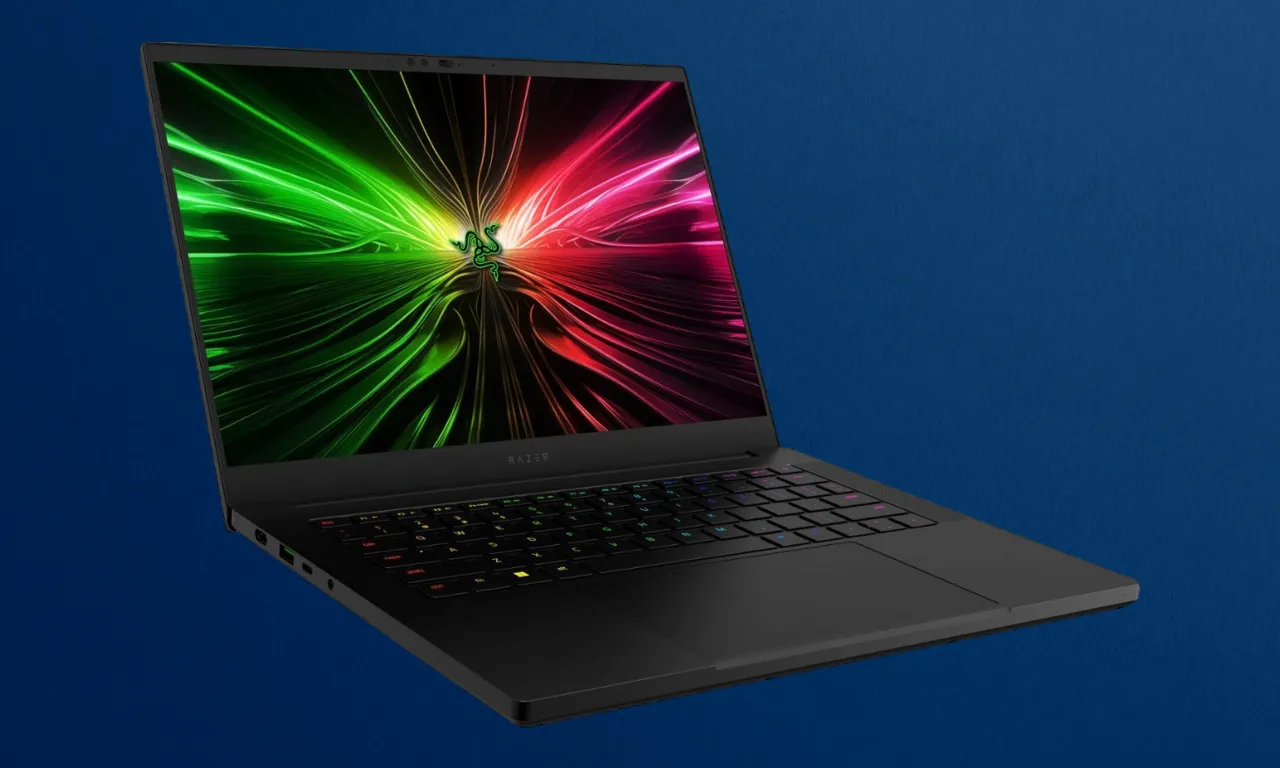Razer Blade 14 (2024) is a machine that isn’t just a gaming laptop but a veritable symbol of high-end tech luxury. Pulling this laptop out in a coffee shop almost feels like a flex, given its sleek design and top-tier performance credentials. This year, though, Razer faces some stiff competition, more so than it has previously. The ROG Zephyrus G14 (2024) steps up as a formidable rival with its stunning chassis, use of top-quality build, and eye-catching OLED display. It’s crafted to appeal directly to the high-end market that Razer has dominated for so long.
For this Razer Blade 14 review, I’ll hone in on the ASUS ROG Zephyrus G14 (2024), which I reviewed with almost the same specs a couple of months ago and I declared it the ‘powerhouse for both gamers and creators.’ Both come shipped including the impressive AMD Ryzen 9 8945HS and Nvidia GeForce RTX 4070 combo, making them ideal for a head-to-head comparison.
So, why Razer Blade 14 is the better choice than its fierce competitor?

The design of your laptop says a lot about it before you even power it on. Right off the bat, the Blade 14 exudes that classic Razer sophistication. It’s sleek, with a strong chassis thanks to its aluminum body that not only looks premium but also feels sturdy in your hands. If you’re familiar with Razer’s design language, you’ll recognize the matte black finish and the subtle green accents. It’s understated yet unmistakably Razer.
Comparing it to the ROG Zephyrus G14, which has also stepped up its game this year, the competition is tighter. The Zephyrus sports a fantastic chassis as well, using premium materials that rival the Blade 14. The G14 has embraced a more minimalist aesthetic too, which might appeal if you’re into a less gamer-centric design. It’s also got the gorgeous OLED display which can be a real head-turner for those who focus more on the screen quality.
But back to the Blade. It’s not just about looking good; the build quality has to hold up to the rigors of daily use and travel. I’ve carted it around from cafes to libraries, and it feels like it can handle being lugged in a backpack without the fear of it picking up dents or scratches too easily. It’s solid, and that reassurance of durability is crucial when you’re investing in a high-end laptop.
In terms of thickness, the Blade 14 isn’t the best on the market, but it strikes a nice balance between being compact and housing powerful internals that need a bit more space to breathe. Sure, it’s a tad thicker than the Zephyrus G14, but we’re talking millimeters here. That slight increase in bulk isn’t something that bothers me personally—it’s a small trade-off for the inside architecture and the great cooling system that doesn’t allow the machine to exceed the temperature figures beyond the limit under heavy loads.

The Razer Blade 14 (2024) comes with a 2560 x 1600 IPS panel, which is pretty sweet to look at. It’s crisp, and bright, and brings colors to life in a way that keeps games and videos looking fantastic. Moreover, it can ramp up to a nice 240Hz refresh rate, making it a dream for gamers who usually play fast-paced titles where every millisecond counts.
Now, comparing this to the ROG Zephyrus G14’s 2880 x 1800 OLED display, there’s a bit of a different story to tell. The G14’s OLED is stunning – the colors appear with a vibrancy that the IPS panel on the Blade 14 can’t quite match. The contrast levels—those deep blacks and bright whites—are incredible on the OLED. And though it’s limited to a 120Hz refresh rate, for many, the sheer beauty of the OLED display might be a trade-off worth considering.
However, there’s more to a screen than only these specs. For instance, the Blade 14’s IPS panel has its own perks. High refresh rates are great for gaming, yes, but IPS panels are generally more reliable in terms of longevity and don’t suffer from burn damage, which can affect OLED panels. So, if you’re likely to have static images on the screen for extended periods, this could be a decisive factor.
The reality is, while the G14’s OLED might steal the show in a side-by-side comparison for movie watching or general multimedia use, the Blade 14’s display is no slouch. It’s geared towards gamers with its higher refresh rate, thus giving a more fluid experience in visuals. And honestly, as far as LCD panels go, it’s definitely at the top of its class. If it weren’t the case that the contender features advanced OLED technology, I’d have no reservations singing its praises even louder.

The Razer Blade 14 (2024) is packed with solid hardware components that aim to push the limits of what a compact gaming laptop can do. Under the hood, this gaming rig is running an AMD Ryzen 9 8945HS paired with an Nvidia GeForce RTX 4070 Mobile graphics card. What sets it apart, though, is how Razer manages to squeeze every bit of power out of that RTX 4070.
Razer cranks up the RTX 4070 to a 140-watt TGP—that’s a 115-watt base + a 25-watt ‘afterburner’. That’s something to be praised and far better than what you see in the Zephyrus G14, which sits around 90 watts. And yes, this difference in wattage translates to real-world performance gains. In my tests, the Blade 14 was consistently about 17-18% quicker at 1080p and 13% with better response at 1440p compared to the Zephyrus. That’s good stats, especially if you’re looking to maximize every frame for a competitive edge.
But here’s something else—because the Blade 14 and the G14 have different native resolutions (the Blade 14’s is lower), it means the Razer has fewer pixels to push. This becomes even more apparent when gaming at those native resolutions. So, in terms of raw gaming performance, the Blade 14 is a clear frontrunner.
The AI-powered AMD’s Ryzen 9 8945HS processor inside the Blade 14 holds a good name in the market; it has eight cores and 16 threads, clocking up to 5.2 GHz. That’s a lot of power for mobile video editing, 3D rendering, and, of course, multitasking like a pro. I ran it through some demanding tasks, and it handled them with relative ease, showcasing both its single-threaded and multitasking productivity. Additionally, the Blade 14 contains a dual GPU setup thanks to AMD’s integrated Radeon 780M graphics. It’s a nice backup addition and a power-efficient option that kicks in for less intensive processes, helping save on battery life and reducing heat output. When you’re not pushing the laptop to its maximum limits where you must use the dedicated RTX 4070, this card helps keep things cooler and quieter, which is a big plus in my book.
I’ve put the Razer Blade 14 through its paces, and honestly, it hasn’t missed a beat. It’s all due to its great combo of the AMD Ryzen 9 8945HS CPU and the RTX 4070 GPU, games like Cyberpunk 2077 ran buttery smooth—no choppiness or annoying screen tearing in sight. I decided to run some Cyberpunk benchmark tests in different graphics settings. Starting with the options by keeping the ray tracing at a minimum, it decently clocked in at an average of 75 FPS. And when I cranked it up to Ultra settings with ray tracing enabled, it still performed well, giving frame rates between 50-60.

In my experience, the Blade 14 manages its thermals impressively well, considering the powerhouse hardware it’s equipped with. What’s really interesting about the Blade 14 is how it balances performance with cooling. Despite running the RTX 4070 at 140 watts, it doesn’t turn into a miniature space heater. Razer has designed a cooling system that includes a densely packed motherboard with a dual fan setup, which is quite impressive for its size. Peeking inside, you can see the meticulous design intended to maximize airflow and cooling efficiency.
Now, as for the noise—it’s there. When you’re pushing the laptop hard, the fans are audible, but honestly, it’s nothing out of the ordinary for gaming laptops. In fact, I didn’t find it much louder than the Zephyrus G14 at the higher tilt. It’s a trade-off, right? You’re getting top-quality performance, so a bit of fan noise in the heat of battle is to be expected.
Razer has historically done well in the battery department, but the Blade 14 takes it a step further. In the 3DMark battery test, it did beat the Zephyrus G14. By keeping the brightness low and without RGB lighting, it proves the Razor’s claim of 10 hours of battery life for this laptop. These are some standout numbers for a gaming laptop. The Razer Blade 14 delivers performance beyond just gaming—it’s reliable enough for routine work, whether you’re knocking out work assignments or powering through college projects. It’s the kind of laptop that won’t let you down, no matter what you throw at it.
Portability is another strong point for the Blade 14. Despite its robust build and cooling needs, it’s still fairly easy to carry around. It’s a bit thicker and slightly heavier than some of its competitors, but there is a difference of a few millimeters and grams—it’s nothing that would deter you from throwing it into a backpack and heading out. This slight increase in size is a reasonable compromise for the cooling performance and battery life it delivers. And speaking of heading out, the Blade 14 comes with a compact 230W power brick that, while proprietary, is amazingly small for the amount of power it delivers. It’s designed to be on the move, without you having to constantly worry about where the nearest power outlet is.
One of the things I always check in a laptop is how easy it is to upgrade and maintain. After all, you want your investment to last and adapt as your needs change. The Razer Blade 14 (2024) gives you a bit of room to work with here. Right after opening the back case, I found access to both the single NVMe slot and dual SO-DIMM slots for RAM right above the 68.1 WHr battery. It’s nice to see that you can boost the memory if needed, our reviewed model includes 32GB of DDR5 alongside 1TB SSD, which is generous but possibly not overkill for future needs.
A 2TB drive would have been more appropriate for a laptop at this price point. Unfortunately, with only one SSD slot, upgrading means replacing the existing drive rather than simply adding more storage. It means you need to spend on a single 2TB drive which shouldn’t be a problem if there was an extra slot to upgrade it by simply equipping an extra 1TB.

Moving on to something a bit more hands-on: the keyboard and trackpad. From the get-go, I was impressed with the Blade 14’s input hardware. The trackpad, first off, is delightfully responsive. It’s got a nice glass surface that translates even the slightest flick of your finger into a smooth motion on the screen. It’s larger than what you might expect in a 14-inch model, giving you plenty of room to maneuver.
The keyboard is equally commendable. The keys have generous spacing, which is a big deal on a more compact model where keys can often feel cramped. The typing experience is comfortable, and I didn’t notice any issues with missed keystrokes, which can sometimes happen with smaller laptops. Moreover, the backlighting is what you’d expect from Razer—subtle but effective, perfect for late-night gaming or typing sessions.
With a price tag of $2,700, the Blade 14 is definitely positioned at the premium end of the market. Now, for that money, you’re getting good performance, great build quality, a solid display, and good battery life. But how does that stack up against the competition? If you’re after the absolute best performance in a 14-inch form factor and value the Razer brand and its design ethos, perhaps that price premium is justified. However, if you’re more price-sensitive and looking for value, then the Zephyrus G14 might make more sense financially.
- Performance is your top priority: If you need the absolute best performance you can get in a 14-inch laptop, particularly if you’re focusing on gaming, the Blade 14 is the way to go. It comes with higher wattage and better thermals to squeeze every bit of power from its components.
- You appreciate a blend of premium design and durability: For those who care about aesthetics as much as performance, the Blade 14 offers a solid build, a sleek design, and a trusted brand name that stands out in both boardrooms and gaming dens.
- You want the best value for money: If your primary concern is getting the most out of every dollar, the Razer Blade 14 might not be for you. It’s pricier than its peers, and while it offers premium performance, similar results can be had for less.
- You prioritize a higher-resolution OLED display: If display quality trumps other considerations, and you’re looking for the deep contrast and vibrant color of an OLED, you might find the Zephyrus G14 more to your liking.
Check Price:






